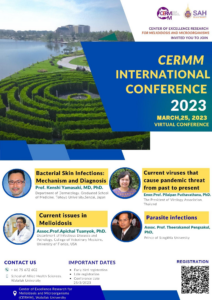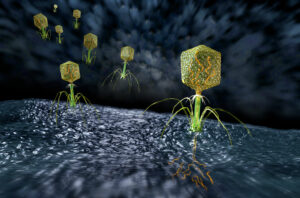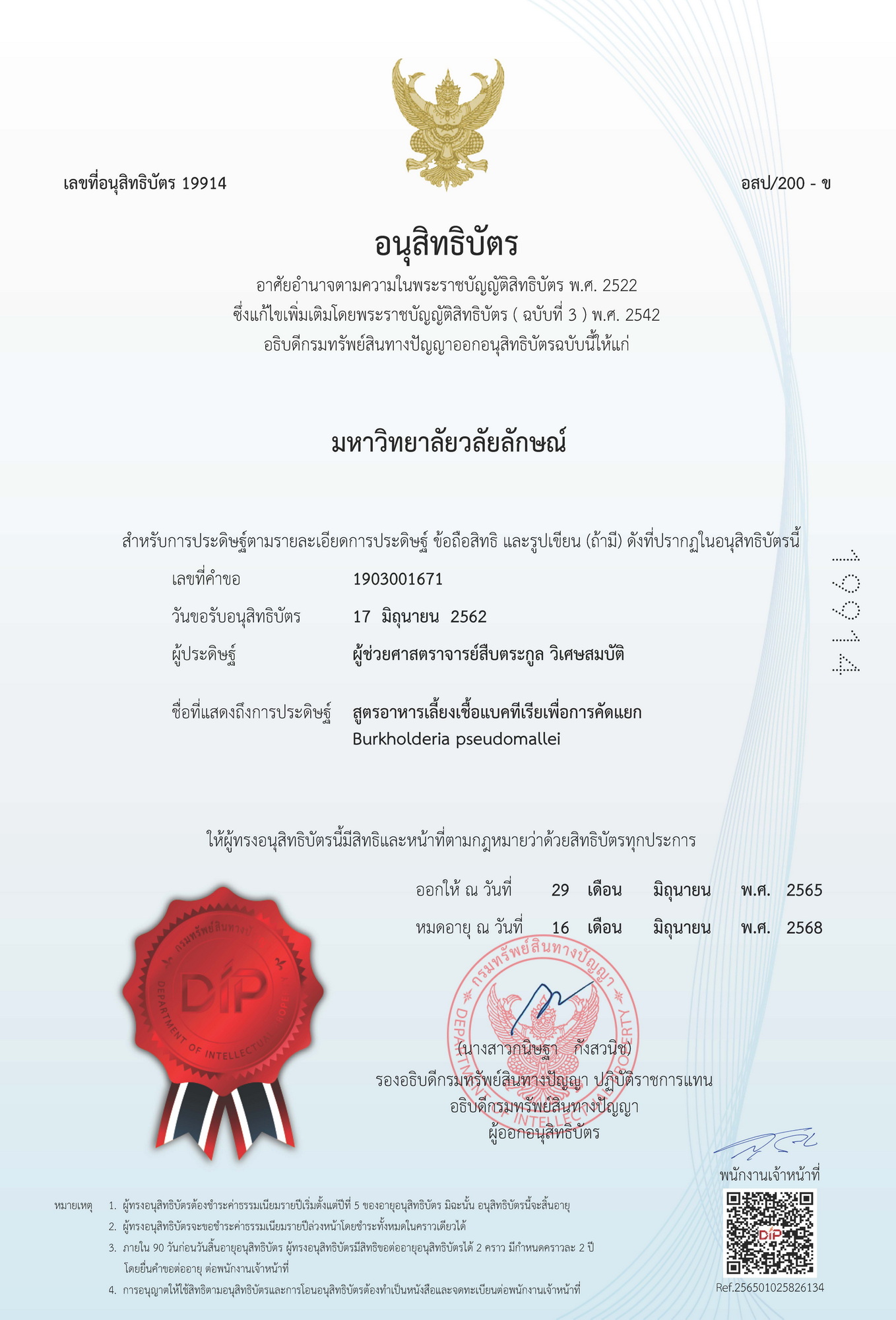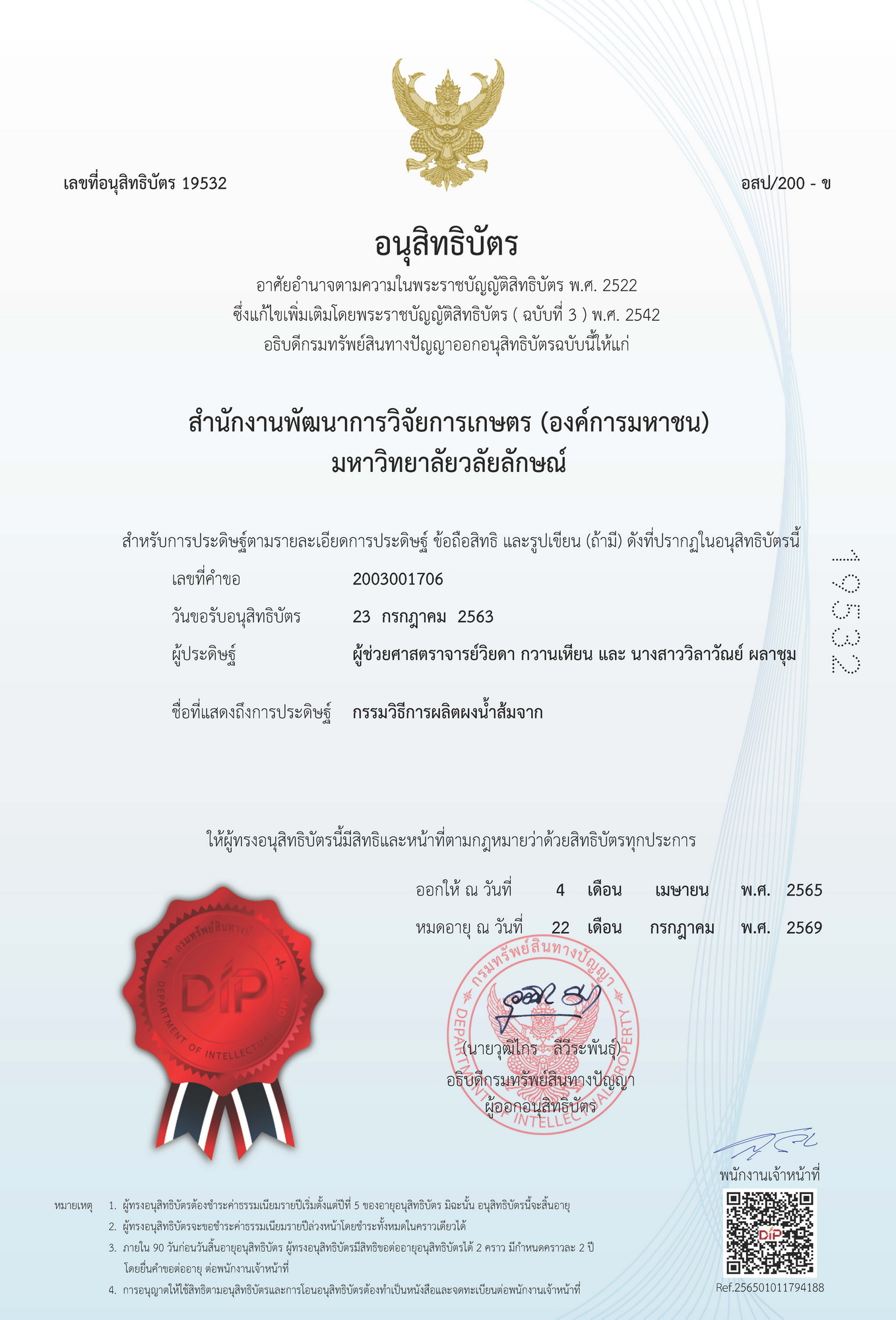HighLight
รศ.ดร.วิยดา กวานเหียน กลางบุตร นำเสนองานวิจัยในงาน
ARDA RESEARCH EXPO 2022 : สุดยอดเกษตรไทยยุคใหม่ สุดยอดเกษตรไทยยุคใหม่ ยกระดับด้วยงานวิจัยและนวัตกรรม
ที่มา : https://fb.watch/fqq4-uXb8u/
มหาวิทยาลัยวลัยลักษณ์ จ.นครศรีธรรมราช สุดเจ๋ง เพิ่มมูลค่า น้ำส้มจากลุ่มน้ำปากพนัง ผลิตเป็น เซรั่ม ไนท์ครีม คลีนซิ่ง
ใช้ได้ผลเทียบเท่าแบรนด์ดัง
ที่มา :https://fb.watch/eZJ1bnT28N/
News
Publication
Diversity of Colony Morphotypes, Biochemical Characteristics, and Drug Susceptibility Patterns of Burkholderia pseudomallei Isolated from Humans, Animals, and Environmental Sources in Thailand
Abstract Melioidosis is an infection that occurs in humans and a wide range of animals by Burkholderia pseudomallei as a causative pathogen, which inhabits environments of tropical and subtropical climate zones, particularly in Thailand. The standard laboratory diagnosis is by culture and biochemical characteristic differentiation. This study aimed to determine the diversity of colony morphology, biochemical characteristics, and drug susceptibility patterns of a B. pseudomallei collection isolated from humans, animals, soil, and water in Thailand. According to the previous characterization of colony morphotypes from Type I to VII, Type I is predominant with B. pseudomallei from humans and animals with
First isolation of verocytotoxin-producing Escherichia coli O157:H7 from sports animals in Southern Thailand
Abstract Background and Aim: Escherichia coli O157:H7 is enterohemorrhagic E. coli, which produces verocytotoxin or Shiga toxin. It is a well-known cause of severe diseases in humans worldwide. Cattle and other ruminants are the main reservoirs of this organism. Sports animals, such as fighting bulls, riding horses, and fighting cocks, are economic animals in Southern Thailand. This study aimed to identify E. coli O157:H7 from the rectal swabs of these sports animals and determine the antimicrobial susceptibility patterns of isolated bacteria. Materials and Methods: The rectal swabs were collected from 34 fighting bulls, 32 riding horses, and 31 fighting cocks.
The efficacy of the traditional Thai remedy “Ya-Ha-Rak” against dengue virus type 2
Abstract Background: Ya-Ha-Rak (YHR) or Bencha-Loga-Wichian is a traditional Thai medicine of polyherbal formulation, comprising five roots, commonly used as an antipyretic and antiseptic. Dengue virus infection exhibits high fever, which is the most common sign of febrile diseases, not just dengue infection. However, thus far, no study has reported the efficacy of YHR against this virus. Therefore, this study aimed to screen in vitro the efficacy of YHR in killing dengue virus type 2 (DENV-2). Method: Water (aqueous-YHR) and ethanol (EtOH-YHR) were used for studying phenolic and flavonoid contents, antioxidant scavenging activity (DDPH and ABTS), and cytotoxicity. In addition,
Evidence of and deaths from malaria and severe pneumonia co-infections in malaria-endemic areas: a systematic review and meta-analysis
Abstract Malaria and pneumonia are the leading causes of childhood mortality in children under 5 years of age. Nevertheless, the proportions and deaths of malaria co-infection among patients with severe pneumonia, particularly in children under 5 years of age, and characteristics of co-infection remain poorly explored. Hence, the present study aimed to collate the evidence of malaria among patients with severe pneumonia, severe pneumonia among patients with malaria, and the proportion of deaths among patients with co-infections. Potentially relevant studies were searched in six databases including PubMed, Scopus, Web of Science, Embase, Ovid, and MEDLINE to identify studies on malaria and severe










